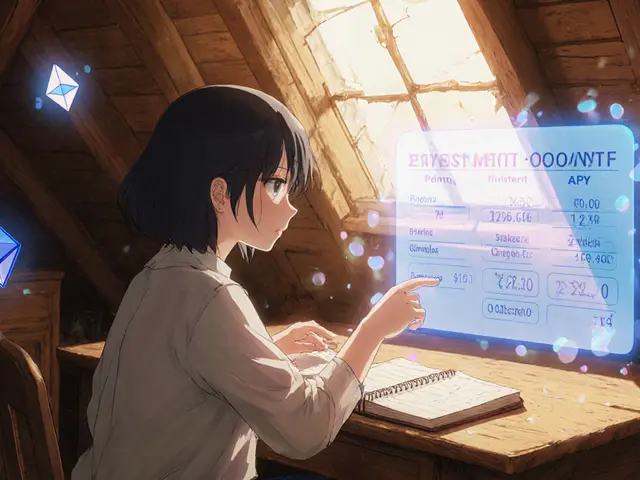19
How to Monetize on Decentralized Social Media Platforms in 2025

DeSoc Platform Fee Calculator
Estimated Monthly Earnings
Enter transaction volume and select platform to calculate earnings
Platform Comparison
Lens Protocol
5% collect fee
Polygon Layer-2
Farcaster
2% tip fee + $0.01 post
Optimism L2
Diamond App
2% coin trade fee
DeSo blockchain
Bluesky
2% tip fee
AT Protocol
When we talk about decentralized social media monetization is a system that lets creators earn directly from their audience using blockchain‑based tokens, NFTs, and smart contracts, we’re looking at a whole new economy that skips the ad‑driven middlemen of Facebook or X.
Imagine getting paid every time a fan likes a post, buys a digital badge, or subscribes to an exclusive feed-no algorithm deciding whether your content is worth a brand deal. That’s the promise many creators are chasing as they migrate to platforms like Lens Protocol, Farcaster, Mastodon, Bluesky, and Diamond App.
Quick Takeaways
- DeSoc platforms reward direct creator‑audience interactions with tokens, NFTs, and subscription fees.
- Most platforms charge a small on‑chain fee (often 1‑5%) that goes to the creator and the protocol.
- Setting up a crypto wallet and learning token economics is the biggest hurdle for newcomers.
- Early adopters can lock in a loyal community and benefit from token appreciation.
- Transparency, ownership, and community governance are the core advantages over legacy social media.
How Decentralized Monetization Actually Works
At the heart of every DeSoc platform is a blockchain that records every transaction on an immutable ledger. When a fan decides to tip, buy an NFT, or subscribe, the smart contract automatically routes the payment to the creator’s wallet. Because there’s no central server deciding who gets paid, creators keep 100% of the revenue after the protocol’s tiny fee.
Key technical pieces include:
- On‑chain tokens - native coins (e.g., DEGEN on Farcaster) or platform‑agnostic stablecoins (USDC, DAI).
- Smart contracts - code that enforces the rules for tipping, NFT minting, and subscription billing.
- Decentralized identifiers (DIDs) - let creators prove ownership of a profile across multiple clients.
- Layer‑2 scaling solutions - Polygon, Optimism, or other roll‑ups keep gas fees under a few cents.
Revenue Streams You Can Tap Into
Most DeSoc platforms bundle several monetization options into a single dashboard. Here’s what you’ll typically see:
- Tipping - Fans send ETH, POL, or stablecoins with a single click. Platforms like Minds, Farcaster, and Diamond App support both crypto and fiat‑to‑crypto bridges.
- Creator Coins - Unique tokens that represent a creator’s reputation. Diamond App’s “creator coin” model lets followers buy, sell, or hold these coins, turning social clout into tradable assets.
- NFT Sales - Limited‑edition digital art, behind‑the‑scenes content, or access passes minted as ERC‑721 or ERC‑1155 tokens.
- Subscriptions & Premium Content - Recurring payments unlock private channels, early‑release videos, or community‑only chat rooms.
- Collect Fees - When users “collect” a post (similar to a tip), Lens Protocol takes a 5% cut that is split between the creator and the protocol.
- Transaction Fees - Some platforms, like Farcaster, charge a flat fee (e.g., $0.01 per post) to curb spam and fund infrastructure.
Platform Deep Dive & Comparison
Below is a snapshot of the five most popular DeSoc platforms in 2025. Each offers a slightly different flavor of monetization, community governance, and technical stack.
| Platform | Native Token | Primary Monetization | Blockchain | Fee Structure |
|---|---|---|---|---|
| Lens Protocol | LENSH | Collect fees, NFT sales, creator coins | Polygon (Layer‑2) | 5% on collects, optional gas‑free minting |
| Farcaster | DEGEN | Tipping, $0.01 post fee, subscription add‑ons | Optimism (Ethereum L2) | 0.01USD per post, 2% on tips |
| Mastodon | None (federated) | Server‑level donations, optional paid instances | Fediverse (no blockchain) | Variable - depends on instance owner |
| Bluesky | AT Protocol (ATOM‑like) | Tip jars, NFT embeds, future creator coins | AT Protocol (Layer‑2) | 2% on tip transfers |
| Diamond App | Creator Coins (per user) | Creator coin trading, likes‑to‑cash, NFT drops | DeSo blockchain (custom) | 2% on coin trades, 0% on likes conversion |

Why Decentralized Beats Traditional Monetization
Traditional platforms monetize user data, not creator effort. The average YouTube partner sees roughly 55% of ad revenue, while a tweet on X rarely earns anything unless it’s part of a brand deal. In contrast, DeSoc platforms hand the revenue stream straight to the creator’s wallet, and the rules are transparent: a 5% fee is visible on‑chain, no hidden algorithmic cuts.
Other advantages include:
- Ownership - Your content lives on a public ledger, so no one can yank it down without your consent.
- Governance - Many platforms run DAOs, letting token‑holders vote on feature upgrades or moderation policies.
- Community‑centric growth - Reputation is earned through direct engagement, not fleeting virality.
- Resilience to demonetization - Since revenue isn’t tied to ad‑friendly content, creators can explore niche topics without fear of a sudden ban.
Getting Started: From Wallet to First Tip
Step‑by‑step, here’s what a creator needs to do to start earning on DeSoc:
- Choose a wallet - MetaMask, Coinbase Wallet, or the native DeSo wallet work on most platforms.
- Fund the wallet - Purchase a small amount of ETH, POL, or USDC to cover gas fees.
- Link the wallet to your profile - Each platform has a “Connect Wallet” button; follow the on‑screen prompts.
- Create a monetization profile - Enable tipping, mint an NFT, or launch a creator coin depending on the platform.
- Promote the payment options - Add a tip button to your bio, share your NFT link, or tell followers about your creator coin ticker.
For creators comfortable with code, Lens Protocol offers a developer SDK that lets you build custom “collect” modules. Non‑technical users can stick with the native UI of Farcaster or Diamond App, which guide you through minting a simple NFT in under five minutes.
Challenges You’ll Hit (And How to Dodge Them)
Even with the upside, the transition isn’t frictionless. Common pain points:
- Learning curve - Understanding gas fees, token swaps, and wallet security takes time. Solution: follow community tutorials on Discord or join a “Web3 Creators” Telegram group.
- Audience education - Followers used to “like” buttons may need a short explainer video on how to tip in crypto. Solution: create a pinned post with step‑by‑step screenshots.
- Volatility - Token prices can swing wildly. Solution: instantly convert earnings to stablecoins using a trusted DEX or built‑in conversion tools on Diamond App.
- Regulatory gray area - Some jurisdictions treat creator coins as securities. Solution: keep transactions under a threshold and stay updated on UK FCA guidance.
What the Future Holds for DeSoc Monetization
Analysts predict that by 2027, at least 15% of global social media ad spend will have shifted to token‑based revenue models. The drivers are clear: user fatigue with data harvesting, growing crypto adoption (global crypto wallets surpassed 300million in 2025), and the rise of DAO‑governed communities.
Key trends to watch:
- Cross‑platform identity - Projects like Farcaster are building portable profiles that work across multiple clients, meaning your audience follows you, not the app.
- Hybrid monetization - Expect traditional brands to sponsor NFTs or creator‑coin campaigns, blending ad spend with direct fan support.
- Improved UX - New wallets are integrating one‑click token purchases, making it almost as easy as a PayPal tip.
- Legal clarity - The UK’s “Digital Assets and Token Regulation” bill is slated for 2026, likely bringing clearer tax rules for creators.
If you’re already building an audience on Instagram or TikTok, consider launching a parallel DeSoc profile now. Early adopters can lock in a dedicated community, test token economics, and reap the upside when the ecosystem matures.
Frequently Asked Questions
Do I need a crypto background to start earning on decentralized platforms?
No. While understanding wallets and gas fees helps, most platforms provide step‑by‑step UI guides. You can begin with a small amount of ETH or USDC, follow the on‑screen prompts, and learn as you go.
Can I convert my creator coin earnings to fiat?
Yes. Most DeSoc wallets integrate with fiat on‑ramps like MoonPay or PayPal‑linked services, allowing you to cash out in GBP or USD instantly.
Which platform offers the lowest transaction fees?
Polygon‑based Lens Protocol typically has sub‑cent gas fees, making it the cheapest for high‑volume “collect” actions. Farcaster on Optimism is close, but occasional network congestion can raise fees.
Is my content truly owned by me on these platforms?
Yes. Content is recorded on-chain and linked to your public key. Unless you delete the data, it remains accessible even if the platform’s UI changes.
How do I protect my wallet from hacks?
Never share your private key or seed phrase. Use hardware wallets for larger balances, enable two‑factor authentication on wallet apps, and only connect to reputable dApps.
Ready to turn your followers into a sustainable revenue stream? Start by setting up a wallet, link it to a DeSoc profile, and experiment with a simple tip button. The sooner you get your first crypto tip, the faster you’ll learn what your community values most.








Kate Roberge
June 19, 2025 AT 03:51Honestly, these DeSoc platforms sound like hype wrapped in fancy tech jargon, but the reality is still messy. You’re supposed to “own” your content, yet you still need to babysit wallets and gas fees. The fee structures they brag about are tiny until you hit real volume, then you start paying more in gas than you earn. Also, most of your fans aren’t even comfortable with crypto, so you’re chasing a niche that refuses to grow. Bottom line: proceed with caution, not blind optimism.
Oreoluwa Towoju
June 19, 2025 AT 06:04Great overview, but remember that onboarding your audience matters most. Keep the tutorial simple and you’ll see better conversion rates.
Nathan Blades
June 19, 2025 AT 09:24There’s a certain romance to the idea of building a community that directly pays you for value, and that spark is exactly what fuels many creators to dive headfirst into DeSoc. First, you break free from the algorithmic shackles that dictate visibility, which means your voice can truly resonate with the people who matter. Second, you get to experiment with a palette of monetization tools-tips, creator coins, NFT drops, subscription tiers-that can be mixed and matched like a DJ set. Third, every transaction is recorded on an immutable ledger, giving you crystal‑clear analytics and proof of earnings that no ad‑network can falsify. Fourth, as the blockchain landscape matures, gas fees are edging toward negligible levels, making micro‑transactions viable. Fifth, the community governance aspect lets you have a say in protocol upgrades, turning users into stakeholders rather than just passive viewers. Sixth, the token economics can appreciate over time, meaning early adopters can benefit from both audience growth and asset appreciation. Seventh, you’re not beholden to a single platform’s policy changes; you can migrate or bridge assets across ecosystems with relative ease. Eighth, the on‑chain identity model gives you a portable reputation that follows you across apps, building long‑term brand equity. Ninth, you can embed decentralized finance primitives-like staking your token to earn yield-right into your creator page, creating a virtuous cycle of value. Tenth, the transparency of fee structures builds trust with your audience, who can see exactly where their money goes. Eleventh, you can leverage existing crypto tools for tax reporting and compliance, making the financial side less daunting. Twelfth, the cultural shift toward valuing digital ownership is already happening, and creators who get in now will shape the narrative. Thirteenth, the sheer novelty of this space attracts media attention, giving you free PR opportunities. Fourteenth, you can collaborate with other creators in the ecosystem to launch joint token projects, amplifying reach. Fifteenth, the decentralized nature protects your content from arbitrary takedowns, preserving creative freedom for the long haul.
Somesh Nikam
June 19, 2025 AT 11:04Solid points! 🎉 Just remember to test your wallet on testnet before going live.
Jan B.
June 19, 2025 AT 13:01Nice summary but watch the fee details are key.
MARLIN RIVERA
June 19, 2025 AT 14:24The article glosses over the volatility risk entirely.
Evie View
June 19, 2025 AT 16:54While the promise of “owning” your content sounds empowering, the reality is a constant hustle with wallet security, gas spikes, and token price swings. If you’re not prepared to manage these moving parts, you’ll end up frustrated. Also, the audience conversion rates are still low compared to mainstream platforms. Don’t let the hype blind you to the operational grind.
Jason Brittin
June 19, 2025 AT 18:01Oh great, another “future of social” piece that pretends crypto is a free lunch 🍽️. Sure, sprinkle some emojis and call it revolutionary, but the user experience still feels like trying to program a toaster.
Amie Wilensky
June 19, 2025 AT 21:04Well, isn’t this just a parade of buzzwords, a cascade of promises, a tapestry of tech‑savvy jargon, a festival of tokenomics, a banquet of fee structures, a symphony of on‑chain transactions, a collage of NFT hype, and, of course, a dash of mysterious “DAOs”.
MD Razu
June 19, 2025 AT 23:18The guide does a decent job laying out the steps, but it underestimates the psychological barrier many creators face when dealing with crypto. First, learning to secure a private key is a whole discipline. Second, the volatility of native tokens can erode earnings fast. Third, most fans simply don’t have crypto wallets set up, so you end up educating them instead of creating. Fourth, platform UI quirks can turn a simple tip into a multi‑step nightmare. Fifth, the legal gray area around creator coins can bite you later. Sixth, gas fee spikes on L2s occasionally spike, making micro‑tips unprofitable. Seventh, community governance proposals can shift fee percentages without warning. Eighth, many of these platforms are still experimental; a sudden outage could lock your earnings. Ninth, you need a backup plan for fiat conversion. Tenth, don’t forget to keep a ledger for tax purposes. All in all, the path is paved with opportunities but littered with hidden obstacles.
Charles Banks Jr.
June 20, 2025 AT 00:58Nice breakdown, but the “future” vibe feels a bit overhyped.
Ben Dwyer
June 20, 2025 AT 02:21Totally agree with the earlier point about education-simple tutorials can make a huge difference for newcomers.
Lindsay Miller
June 20, 2025 AT 04:18Good info. Keep it simple for people just starting out.
Katrinka Scribner
June 20, 2025 AT 05:24Wow, this is super helpful! 🤩 I’vve already set up my wallet and c’nt wait to try the tip button.
VICKIE MALBRUE
June 20, 2025 AT 06:48Start small and scale.
Waynne Kilian
June 20, 2025 AT 08:28Honestly, the ideas sound promising, but the tutorial part could be better. Some users might get confused by the steps, especially if the UI isn’t intuitive. A few screenshots would go a long way in clearing things up.
Naomi Snelling
June 20, 2025 AT 09:51They’re probably hiding the fact that these platforms are just a front for data collection.
Michael Wilkinson
June 20, 2025 AT 11:48Enough with the soft talk-if you can’t handle the fees, don’t bother.
Billy Krzemien
June 20, 2025 AT 14:01Excellent summary. The comparison table is especially useful for quick reference.
april harper
June 20, 2025 AT 15:41Another layer of tokenomics, another layer of drama.
Clint Barnett
June 20, 2025 AT 18:11What really excites me about this space is the sheer creativity it unlocks. First, you can mint a limited‑edition NFT that doubles as an access pass, turning scarcity into community building. Second, creator coins let fans speculate on your future success, creating a market where your reputation is literally tradable. Third, the ability to embed smart contracts means you can automate royalties on content resharing-something impossible on legacy platforms. Fourth, cross‑platform identities give you the power to consolidate your audience across Lens, Farcaster, and Bluesky without being locked into a single silo. Fifth, the governance tokens let you have a real say in protocol upgrades, turning you from a passive user into a stakeholder. Sixth, low‑fee L2 solutions like Polygon and Optimism keep micro‑tips viable, so even a $0.01 tip makes sense. Seventh, you can integrate fiat on‑ramps directly into the UI, letting non‑crypto fans tip with a credit card and you receive stablecoins. Eighth, the transparency of on‑chain analytics helps you fine‑tune your content strategy with real, immutable data. Ninth, the community‑driven ethos reduces the likelihood of arbitrary demonetization, fostering a safer space for niche creators. Tenth, the future will likely see hybrid brand‑sponsored NFT drops, blending traditional advertising with decentralized ownership. Eleventh, as more wallets become user‑friendly, the onboarding friction drops dramatically. Twelfth, the open‑source nature of many DeSoc projects invites collaboration and innovation you just can’t get from closed ecosystems.
Jacob Anderson
June 20, 2025 AT 19:34Sure, if you enjoy paying yourself in crypto riddles.
Kate Nicholls
June 20, 2025 AT 21:14Helpful guide, but watch out for hidden fees.
Carl Robertson
June 20, 2025 AT 23:11Another epic saga of token hype-brilliant, really.
Rajini N
June 21, 2025 AT 01:24To add to the earlier technical points, many of these platforms now support ERC‑4626 vault standards, allowing creators to auto‑compound earnings directly from tip streams. This means you can earn interest on your incoming tips without leaving the platform, which is a game‑changer for sustainable revenue.